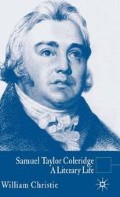Abstract
‘Frost at Midnight’ was published along with ‘Fears in Solitude’ and ‘France: An Ode’ in a small quarto of 23 pages by the famous radical publisher Joseph Johnson, friend of William Godwin and Mary Wollstonecraft and founder of the Analytical Review, whom Coleridge met a number of times during his stay in London before embarking for Germany. Johnson, in turn, gave Coleridge a letter of credit for £25 to be cashed by an English bookseller in Hamburg, though Coleridge protested to his wife that the money was for work to come, not for work completed (CL I, 417–18, 417n.). It is just possible that Johnson paid for the volume itself in cash at the time and invested a little more in Coleridge’s future, having received him ‘civilly the first time’, according to Coleridge, ‘cordially the second, affectionately the third’, before finally taking leave of him ‘with tears in his eyes’ (CL I, 420). Once again, Coleridge’s ‘one-versation’ had endeared him to a willing patron.
Access this chapter
Tax calculation will be finalised at checkout
Purchases are for personal use only
Preview
Unable to display preview. Download preview PDF.
Notes
William Hazlitt, ‘My First Acquaintance with Poets’, in William Hazlitt: Selected Writings, ed. Jon Cook (Oxford and New York: Oxford University Press, 1991), pp. 211–30 (p. 226).
For comment on Coleridge in intellectual debate with his teachers, see Charles Parry’s letter home from Gottingen, reprinted in Clement Carlyon, Early Years and Late Reflections, in 2 vols (London 1836), I, 100-ln.
See Gary Kelly, The English Jacobin Novel 1780–1805 (Oxford: Clarendon, 1976).
Text from The Oxford Authors edition of Byron, ed. Jerome J. McGann (Oxford and New York: Oxford University Press, 1986).
See below, on The Friend in Chapter 7 and the Biographia in Chapter 8, and for a context, Marilyn Butler, Romantics, Rebels and Reactionaries: English Literature and Its Background 1760–1830 (Oxford and New York: Oxford University Press, 1981), chapter 6, ‘The War of the Intellectuals: from Wordsworth to Keats’, pp. 138–54.
The most comprehensive and relentless study of Coleridge’s plagiarisms remains Norman Fruman, Coleridge, the Damaged Archangel (London: George Allen & Unwin, 1972),
which it is recommended should be read with Thomas McFarland, Coleridge and the Pantheist Tradition (Oxford: Clarendon, 1969).
Jeffrey’s construction of Wordsworth, Southey, and Coleridge as a ‘school’ from 1802 onwards (a school to which, incidentally, other poets like Wilson and Joanna Baillie were occasionally added) is discussed by David Perkins in his essay ‘The Construction of English Romantic Poetry as a Literary Classification’, reprinted in his Is Literary History Possible? (Baltimore and London: Johns Hopkins University Press, 1992), pp. 85–119 (pp. 88–91).
For a convenient conspectus of English newspaper history, see Jeremy Black, The English Press 1621–1861 (Stroud: Sutton Publishing, 2001).
Jon P. Klancher, The Making of English Reading Audiences, 1790–1832 (Madison, WI: Wisconsin University Press, 1987), p. ix.
Southey’s best known works include the long poems Thalaba (1801),
Madoc (1805),
The Curse of Kehama (1810),
and Roderick, the Last of the Goths (1814);
his edited collections Specimens of the Later English Poets (1807)
and Select Works of the British Poets, from Chaucer to Jonson (1831);
his biographies of Nelson (1813), Wesley (1820), and the British Admirals (1833–7);
histories of Brazil (1810–19), Europe (1810–13) and of the Peninsular War (1823–32); literary translations of Amadis of Gaul (1803)
and the Chronicle of the Cid (1808);
and literary editions of Chatterton (1803), Pilgrim’s Progress (1830), Isaac Watts (1834), and Cowper (1835–7).
Copyright information
© 2007 William Christie
About this chapter
Cite this chapter
Christie, W. (2007). ‘The Toil of Thinking’: Private Notes and Public Newspapers. In: Samuel Taylor Coleridge. Literary Lives. Palgrave Macmillan, London. https://doi.org/10.1057/9780230627857_6
Download citation
DOI: https://doi.org/10.1057/9780230627857_6
Publisher Name: Palgrave Macmillan, London
Print ISBN: 978-0-230-58096-1
Online ISBN: 978-0-230-62785-7
eBook Packages: Palgrave Literature & Performing Arts CollectionLiterature, Cultural and Media Studies (R0)

